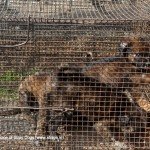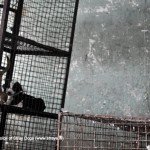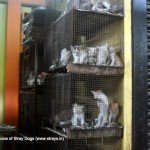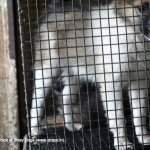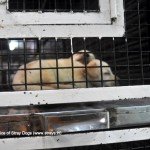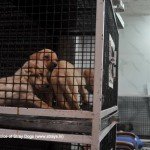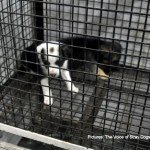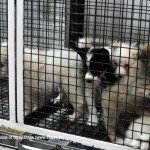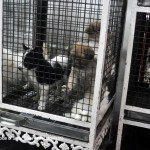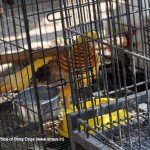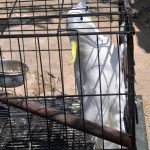[The Voice of Stray Dogs investigation report]
We’ve written about the correlation of dogs with garbage repeatedly, and its known that dogs and illegal meat shops and slaughter don’t mix. But what of a meat and a dog market within one building! How does that one look like?
Pretty much anyone who’s familiar with Bangalore would be familiar with Russell Market – a quaint old building selling flowers, fruits and vegetables in a 90 yr old building. Quintessentially Indian. Quintessentially Bangalore. At the end of this and at a 90 degree angle to it is a large red oxide painted building proudly saying “Beef Market 1932”. This is clearly a gift from the British time but of course no-ones’ heard about the Beef Slaughter prohibition in Karnataka (so where exactly have the Karnataka Rakshana Vedike and other extreme right and right of center parties gone about this one?)
As you walk down to the Beef Market you need to pass chicken & turkeys being thrown around and sheep being cut and displayed out in the open. This is where all the large restaurants in Bangalore buy their meat from. No manager or management theor cares where their meat comes from. Farm to fork is an alien concept still.
As we reach the Beef Market some shopkeepers tell us immediately we can’t photograph – that I did was as surreptisouly as possible with the camera hanging from my neck – this was not even a point to shoot expedition. At the Beef Market they don’t only sell Beef they also sell dogs! I do not mean dog meat (which is available elsewhere in Biryani shops masquerading as goat/ sheep) but live dogs – hundreds of them. There are many things assault any sense of humanity at this Dog-Beef market:
- To begin with its the same building – 1 side of a the building is the ‘pet’ market which is dogs, cats’ birds in that order. A dark corridor with shops on one side and an open large toilet on the other that ends in a large shop selling ducks, geese and other large birds in cramped cages. And feed.
- There are about 10 ‘shops’ each about 15-20 sq feet with cages piled from floor to the ground one on top of the other full of puppies and kittens. The birds are take out to be displayed in the open.
- We could not see one dog that you’d call healthy and ALL cats had eye infections
- Puppies are kept 5-10 in a cage for small breed like Indian Spitz’s and 2-3 for larger ones like Labradors. Even at that age they do not look like the specimens that you see in real life or in pictures – gaunt, inbred, deformed- but I guess their buyers don’t know any better and just want a dog for their children or to keep up with their neighbors
- We could clearly see, since it was early in the day:
- Each morning all the cages are ‘unstacked’ and some of them are brought outside for display and to lure the customer. You can hear the constant whining and crying and the pups from a distance.
- Each puppy is roughly taken out of the cage and mopped with a rough cloth to remove any debris from the night in the cage crammed with other puppies, of faeces etc. You could see special ‘attention’ on the eyes and faces of these dogs to make sure that the faces and eyes are clean. This is done roughly with a dry cloth. But those eyes have lost their light already. The look of a constant pain when at the age of a month you don’t even want to live anymore but the animal instinct to eat and survive doesn’t let you die.
- Clearly some pups were deformed, all looked distressed, most were malnourished and some on the verge of death – there were 2 who had lost most of their hair and were barely breathing
- The cats and dogs are in the same building as the meat market – you’d think they’d be fed well. What’s more ironical the largest shop at the end of the corridor sells dog food – where there are stacks of Pedigree food piled upto the ceiling.
Very few answers were forthcoming no-one wanted to talk to us. But we had relevant questions:
- Where do these pups come from?
- What are they fed?
- What do you do if you can’t sell them in the 15day – 1 month window when they still can be sold?
- Is there any medical attention at all?
This is clearly one of the fronts of the dark puppy mills of Bangalore. When we came back I started talking to people and looking for provisions to do something about a place like this. The first responses I had were:
- Don’t take on these people they are dangerous
- There’s nothing that you can do about it
- There’s nothing in law that can prevent of change this from happening
A law or a set of laws and a state that can’t help the voiceless has little to moral ground to stand on. But nevertheless we started looking for help including that of a fellow volunteer and lawyer. There may not be any direct remedy but something can be done and we need to do it.
- Welcome to the Beef Market
- There’s the animal section on the left
- Birds, dogs, cats anything that can be in a cage, is
- The display case
- “GSD” pups out in the sun
- These guys will perhaps never make it
- As the day begins some of the stacks are moved out
- Cats – stacked sky high 🙁
- An ‘Indian Spitz’ most likely a mongrel
- The light has gone of the little lives
- Inbred but brothers nevertheless
- Labrador pups… notice the series of cages behind
- What a life!
- The upmarket dogs in upmarket cages
- The Spitz army that has already lost the battle
- Who wants to them home? If the money on the wrought iron work could be used for a little food instead!
- Exotic birds in cages in the sun
- Exotic birds in cages in the sun
What we saw not something that is new or unique in the world of breeding or per shops
I
In the year 2009-2010, a need was felt for the formulation of Rules to govern and regulate the operations and functioning of pet shops and dog breeding, marketing and sales establishments, because an alarming increase in both was apparent to all concerned, including municipalities, State Government functionaries, and Central Government functionaries. The Animal Welfare Board of India, which has been specifically empowered under the Prevention of Cruelty to Animals Act, 1960, “to keep the law in force in India for the prevention of cruelty to animals under constant study and advise the Government on the amendments to be undertaken in any such law from time to time” [Section 9 (a) of the Act] was required by the Ministry of Environment and Forests, under whose aegis the Board functions, to draft comprehensive Rules for the purpose, which it did.
These Rules were posted on the website of the Ministry of Environment and Forests ; objections, if any, invited ; objections received from those interested ; objections addressed ; and the draft Rules, duly finalized by the Board, submitted by the Board to the Ministry of Environment and Forests in July, 2010, for the latter’s consideration. Eventually the Rules were posted again, on the Ministry’s website, in February, 2011.
The Preambles to the draft Rules, say it all. The reasons why the enactment of these Rules is urgently required, is captured in their Preambles, which read as follows :
“PET SHOP RULES, 2010
PREAMBLE
In the last decade, with the liberalization of the economy and the increase in purchasing power, several new trades have come into being. One of these is the mushrooming, and yet unregulated pet trade in live animals, that are capable of experiencing discomfiture, pain, hunger and thirst just as humans do. Live animals are exhibited and traded like commodities in pet and pet product shops. These Rules are intended to ensure their humane handling, and to regulate this trade. Since the mute cannot complain, the responsibility to ensure compassionate and empathetic handling is greater. Since pet shops are commercial establishments, they have to be regulated with licenses, and parameters of operational standards. Uniform practices and procedures have to be prescribed, and adhered to by those partaking in the profits derived from this brand of commercial activity. Consequently, the Pet Shop Rules have been formulated by virtue of the power conferred by Section 38 of the Prevention of Cruelty to Animals Act, 1960.”
“DOG BREEDING, MARKETING AND SALES RULES
PREAMBLE
Breeding, marketing and sales of dogs has come to stay as a high-level commercial venture in India, involving thousands of breeders and pet shops in a multi-crore industry. An enormous need has also emerged for lakhs of pups of specific breeds from prospective pet owners, most of whom are ignorant regarding the basics of healthcare and management of dogs. This has resulted in the mushrooming of unscrupulous breeders indulging in backyard breeding activity in the most unhygienic conditions, cruelly exploiting the animals for easy money ; and in pet shops sourcing and selling pups from such breeders, which, though seemingly of pure breed, are actually of poor quality, and often diseased, resulting in heavy mortality, or weak and unhealthy animals that are ill-treated, and in many cases simply abandoned on the street. Not only is this compounding the street animal problem, this unethical trade also has high zoonotic potential which is a public health concern.
There is hence an immediate need to discipline and regulate the process of dog breeding, marketing and sale of pups. Uniform practices and procedures have to be prescribed, and adhered to by those partaking in the profits derived from this brand of commercial activity. Consequently, the Dog Breeding, Marketing and Sales Rules have been formulated by virtue of the power conferred by Section 38 of the Prevention of Cruelty to Animals Act, 1960.”
There is a pressing need, but these Rules have not been formally enacted till date. They are stated to be pending with the Law Ministry.
II
Also formulated by the Board, and submitted to the Ministry of Environment and Forests in final form for their consideration in June this year, after taking into account, all challenges faced, and all developments subsequent to the enactment of the Prevention of Cruelty to Animals Act, 1960, is the draft Animal Welfare Act, 2011. This draft law framed by the Board is a powerful document, which, if enacted, shall be the antidote for many ills. In any event, this is also currently pending with the Ministry of Environment and Forests.
III
Excessive and unscrupulous breeding (including inbreeding), and marketing of companion animals (especially dogs), and their sale, either directly from the breeding establishments, or through pet shops, some of which are well equipped and suited to care for the animals they house, but an increasing number of which do not have the wherewithal to tend to the animals incarcerated in their ‘facilities’, is rampant. Animals are used for breeding, and then again, and yet again ; and horrible tales of inbreeding, and incarceration, and ‘chained / caged for life’ surface every now and then. Mother dogs are exploited horribly, not medically tended to, often left to feed in garbage heaps, ‘used’ only for as long as they have the capacity to litter, and abandoned thereafter. As are male dogs abandoned, by breeders, and by irresponsible ‘pet’ owners, no longer ‘able’ to, or wanting to be saddled with a ‘pet’.
One of us personally knows of a lhasa apso dog thrown out of a moving car, hit by a motor cyclist, his left hind leg fractured as a consequence, and his right hind leg sprained, dragging himself some distance away, and then slowly waiting for death on a road near Pragati Maidan, Gate Number I. This was on 19th February, 2011, i.e. 4 days after he was thrown ; and this saga of his ‘throwing’ was revealed by the children at a jhuggi close by, who had witnessed it all. He was in a terrible state, with matted hair, and very aggressive, probably because he had been treated very badly. He was rescued by the Spca Noida staff, and is now a permanent resident at the Spca Noida shelter cum hospital. His fracture has healed, his temperament improved, and he is actually friendly with the kitchen staff ! He’s called Lhaso, and he made it, but many don’t. Several die on account of their abandonment, of slow but steady starvation and thirst, or attacks by other dogs, or in accidents on the roads. Several are too far gone by the time they are rescued ; and cant be saved. Many just waste away, waiting for a home, waiting for the ‘guardian’ who abandoned them to come and get them back. The point being, that availability of this nature of ‘commodity’ is at an all time high ; and regulation of ‘production’ and sales at an all time low. There is therefore, tremendous cruelty, suffering, and abandonment / discarding of ‘stock’ that ceases to serve, and of ‘pets’ that become inconvenient. Every animal shelter, for instance, therefore has its share of abandoned animals, often ailing, often with broken hearts ; but unfortunately, not all of them make it to shelters, or get rescued. Which is why the Preamble to the draft Dog Breeding, Marketing, and Sales Rules affirms that : “Not only is this compounding the street animal problem, this unethical trade also has high zoonotic potential which is a public health concern.”
POSSIBLE SOLUTIONS :
IV
The scenario is bleak, because of inadequate regulation, and apparently inadequate political will to regulate this ‘brand’ of trade and commerce, notwithstanding that it involves live, sentient beings that experience pain and suffering, as do, we. In this scenario, what an ordinary compassionate citizen can do, and the laws and enactments he can turn to, is what this article focused on, because clearly, we cannot let things be.
V
In the first place the Prevention of Cruelty to Animals Act, and the solutions it provides, may be looked at. Sections 3 and 11 set out, respectively, the ‘Duties of persons having charge of animals’, and what is ‘Treating animals cruelly’. Both of these would apply to Pet Shops, and Dog Breeding, Marketing, and sales establishments ; and the owners / in charge of any such establishment can be booked for cruelty perpetrated by them. Why this remedy is not very efficacious is because the penalties provided for are abysmally low –
“he shall be punishable, [in the case of a first offence, with fine which shall not be less than ten rupees but which may extend to fifty rupees, and in the case of a second or subsequent offence committed within three years of the previous offence, with fine which shall not be less than twenty-five rupees but which may extend to one hundred rupees or with imprisonment for a term which may extend to three months, or with both.]
(2) For the purposes of sub-section (1), an owner shall be deemed to have committed an offence if he has failed to exercise reasonable care and supervision with a view to the prevention of such offence:
Provided that where an owner is convicted of permitting cruelty by reason only of having failed to exercise such care and supervision, he shall not be liable to imprisonment without the option of a fine.”
Moreover, the offences set out in most sub-sections of Section 11, are non-cognizable. The police cannot take cognizance of the same, on a complaint filed by you ; and you’d have to file a complaint in Court. In some cases the same may be warranted, but why it may prove harassing for some, is because in the case of a criminal complaint filed, the complainant has to be present before Court on each date, as has the accused, after the accused is summoned. Of course, in some cases, it may be warranted, to get an entity / individual formally declared animal offender, through his conviction in court.
VI
The Indian Penal Code, Sections 428 and 429, can be looked at next. These provisions of law are efficacious, and the offences cognizable, i.e. the police can take cognizance. However, these can be pressed into service only when the deed is done – “maiming or rendering useless any animal or animals”. In such a case, a complaint can be lodged with the police ; and if you are possessed of sufficient data – pictures, or even veterinary reports/medical bills, if any – to demonstrate that the pet shop owner / breeding establishment is responsible for maiming or rendering useless, an animal or animals, the police would have to register an F.I.R. and commence investigation.
VII
If you are an ‘aggrieved consumer’, and the ‘merchandise’ you purchase is ‘defective’, i.e., if you source a pedigreed animal, for instance, from a pet shop or a breeding establishment, and are possessed of proof of purchase, and the little one is diseased, or sickly on account of inbreeding or other lack of care, you can consider filing a complaint against the seller under the Consumer Protection Act, for ‘defect in goods’, or even for resort to ‘unfair trade practice’, i.e. holding out an animal to be, what he turns out not to be – healthy. You can sue for damages under the said law ; and a complaint of the value of up to Rupees Twenty lakhs would fall within the pecuniary jurisdiction of the District Consumer Disputes Redressal Forum of the area where your cause of action arises. That is to say, you can make a claim for damages for a value below, or equal to Rupees Twenty lakhs only, at a District Consumer Disputes Redressal Forum. Consumer Courts are meant to be consumer friendly ; and for lodging a complaint, you have to pay nominal fee, and do not have to follow any particular format. You must, of course, be possessed of proof of purchase, and proof of damage suffered : such as veterinary bills, invoices of medicines purchased, etc.
VIII
By far the best solution may however be, that you require your municipality to act.
Under Section 346 of the Karnataka Municipal Corporation Act, 1976, a pet shop, or other breeding establishment, would need to be licensed, and operate under a license issued by the Commissioner. [There are similar provisions in all municipal enactments. The relevant provision in the Delhi Municipal Corporation Act, 1957, is Section 417.]
The use of any place for any such purpose would have to be in conformity with the license granted by the Commissioner.
Under Section 372 of the Karnataka Municipal Corporation Act, 1976, the grant of a license, or renewal of a license upon application for renewal being made, can be refused or withheld by the Commissioner, if the owner or occupier of the premises in question does not comply with the terms that the Commissioner chooses to impose, and with the requirements specified by him. Section 443 of the said Act provides for revocation of licenses, and for inspections to be conducted prior to precipitate steps being taken. [Corresponding provisions in the Delhi Municipal Corporation Act, 1957, are Sections 430, and 431.]
You can therefore :
Validly bring it to your Commissioner’s notice (preferably in writing), that any pet shop or breeding, marketing or sales establishment, is acting without a license issued by the municipality (Commissioner), if that is so ; or
-
Is acting without a valid license, such as a license that has lapsed, and has not been renewed ; or
-
Is acting in contravention of the terms of license, or acting in contravention of the municipal enactment, or in contravention of any law ; or
-
That the license granted to any such entity or individual, or a license renewed, was a result of fraud or misrepresentation by such entity or individual, and ought not to have been granted or renewed.
Set out all problems / aberrations as you perceive them to be, and demand, in writing, that the municipality act and require the license holder to operate, and conduct with trade business or occupation in a certain, lawful, manner. Demand that if the license holder fails to comply, his license be suspended, or even revoked after following the due process of law.
Several animal welfare persons / concerned compassionate citizens writing to the municipality in this manner, regarding rogue entities or individuals, can bring considerable pressure to bear upon the municipality.
If the municipality still doesn’t act, a writ petition can be filed before the Court of appropriate jurisdiction, requiring that a writ order or direction be issued to the municipality, requiring that it act in accordance with its mandate in law.
IX
Remedies for offences against animals, provided in the Prevention of Cruelty to Animals Act, may not be very efficacious. However, most State Police enactments consist of provisions that may prove more onerous for animal offenders, and more effective for those that seek to prosecute animal offenders. In this regard, refer to Sections 74, and 93 of the Karnataka Police Act, 1963, or Section 78 of the Delhi Police Act, 1978. What can perhaps be tried, is this :
That you attempt to demonstrate to the police station / official having jurisdiction over the territorial location where the pet shop or breeding, marketing or sales establishment exists, through a written complaint, and other corroborating data such as pictures, etc., that what is occurring at the same is ‘cruelty’ as defined under the Prevention of Cruelty to Animals Act. The police officer, in such a case, is empowered to effect arrests without warrants, i.e. even though the offence may otherwise be non-cognizable, under the Prevention of Cruelty to Animals Act. This ‘method’ can also be tried, and several complaints against each such recalcitrant entity or individual lodged, so that some pressure is brought to bear on the police station / officer concerned, to act







